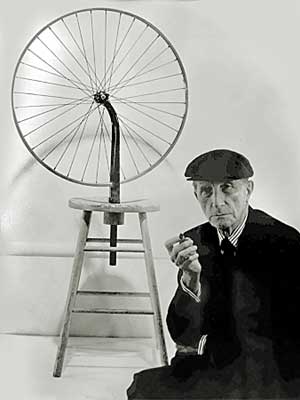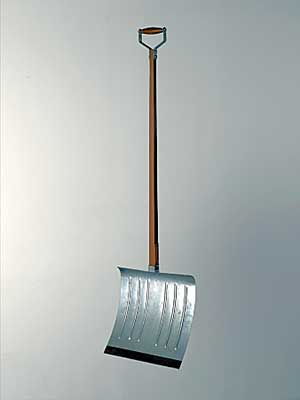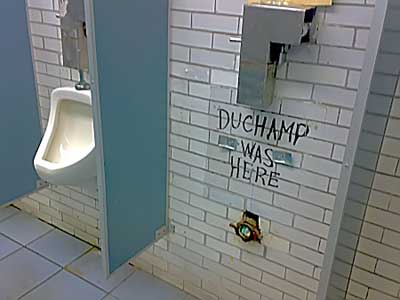3D Art
Found Object Project
"Whether Mr. Mutt with his own hands made the fountain or not has no importance. He CHOSE it. He took an ordinary article of life, placed it so that its useful significance disappeared under the new title and point of view - created a new thought for that object." - Marcel Duchamp (writing under the pseudonym, The Blind Man; follow this link to read the English version of Duchamp's self-published booklet from 1917, The Blind Man).
"Art is not a mirror held up to reality, but a hammer with which to shape it." - Bertolt Brecht
Theory
Please note: This project dovetails with Project 6, Conceptual / Visual-Metaphor / Interactive-Sculpture, which describes how found objects are sometimes used to create visual metaphors. These are two, separate-but-related ways of working: both are conceptual in orientation, but the project that I describe here is more analytic (takes apart the various aspects of an idea or an object to discover a deeper and more speculative level of meaning) whereas the visual-metaphor project is more synthetic (brings together several ideas to arrive at a new understanding, with properties that are similar to a metaphor). This is all theoretical, of course, so you should have a closer look at both projects before you begin your work to see which one resonates with you.
Also, remember that an artist may modify a found-object anywhere along a continuum that begins with very few changes (like Duchamp's, Fountain, 1917 or Prelude to a Broken Arm, 1915), and proceeds from there toward objects that have dramatic alterations (like Duchamp's Bicycle Wheel, 1913). The severity of modification depends, of course, on how the artist intends to use the object (the meaning that she's trying to communicate).
The next 3 paragraphs are from Wikipedia: http://en.wikipedia.org/wiki/Found_art
Found object originates from the French objet trouvé, describing art created from undisguised, but often modified, objects or products that are not normally considered materials from which art is made, often because they already have a non-art function. Pablo Picasso first publicly utilized the idea when he pasted a printed image of chair caning onto his painting titled Still Life with Chair Caning (1912). Marcel Duchamp is thought to have perfected the concept several years later when he made a series of ready-mades, consisting of completely unaltered everyday objects selected by Duchamp and designated as art. The most famous example is Fountain (1917), a standard urinal purchased from a hardware store and displayed on a pedestal, resting on its side. In its strictest sense the term "ready-made" is applied exclusively to works produced by Marcel Duchamp, who borrowed the term from the clothing industry (French: prêt-à-porter, lit. 'ready-to-wear') while living in New York, and especially to works dating from 1913 to 1921.
Found objects derive their identity as art from the designation placed upon them by the artist and from the social history that comes with the object. This may be indicated by either its anonymous wear and tear (as in collages of Kurt Schwitters) or by its recognizability as a consumer icon (as in the sculptures of Haim Steinbach). The context into which it is placed is also a highly relevant factor. The idea of dignifying commonplace objects in this way was originally a shocking challenge to the accepted distinction between what was considered art as opposed to not art. Although it may now be accepted in the art world as a viable practice, it continues to arouse questioning, as with the Tate Gallery's Turner Prize exhibition of Tracey Emin's My Bed, which consisted literally of a transposition of her unmade and disheveled bed, surrounded by shed clothing and other bedroom detritus, directly from her bedroom to the Tate. In this sense the artist gives the audience time and a stage to contemplate an object. As such, found objects can prompt philosophical reflection in the observer ranging from disgust to indifference to nostalgia to empathy.
As an art form, found objects tend to include the artist's output—at the very least an idea about it, i.e. the artist's designation of the object as art—which is nearly always reinforced with a title. There is usually some degree of modification of the found object, although not always to the extent that it cannot be recognized, as is the case with ready-mades. Recent critical theory, however, would argue that the mere designation and relocation of any object, ready-mades included, constitutes a modification of the object because it changes our perception of its utility, its lifespan, or its status.
Wikipedia insertion ends here (click this link to continue reading the article).
Today, many artists are appropriating and modifying well-known objects. Some of these objects, fashion dolls for instance, are loaded with implicit meaning: messages that originate in a cultural context of related values and expectations. Once the artist modifies the object, often through parody or satire, an alternate meaning emerges. This new significance will probably be more faithful to the vagaries of modern life and less compatible with the commercial interests of the company that markets the object.
When an object undergoes this process of deconstruction, it ceases to embody only the manufacturer's narrow and idealized sentiments and instead, it becomes saturated with the artist's understanding of the greater socio-political context in which the object exists. The values that gave rise to the object in the first place are now explicit, allowing the viewer to examine their relative merit.
Fashion-Doll Example
Thus, in an era where women are expected to have hour-glass figures, Matel® has given the Barbietm doll a body-shape that's idealized to an extraordinary degree. If an actual female had the proportions of a Barbietm doll, her waist would measure about twelve inches around while her chest would measure a staggering fifty inches in circumference! One might ask, "What implicit message does the original Barbietm doll give young girls about the qualities of being a woman?" Questions like these have inspired Nickolay Lamm to design an alternate version of the fashion doll: one that has natural proportions, stick-on stretch marks and even scars. In essence, Lamm created an "anti-Barbietm" that beautifully encapsulates a new, enlightened ethos for the 21st century (see the link below).
Here are links to three views of Barbietm; two opposing views from popular culture and one from academia:
- Click here to read "The Wonder of Barbie: Popular Culture and the Making of Female Identity" by Lenore Wright in Essays in Philosophy, A Biannual Journal, Vol. 4 No. 1, January 2003.
- Click here to see an image of Valeria Lukyanova, a 21 year-old woman from the Ukraine who is becoming a REAL LIFE Barbietm doll.
- Above, is an image of a more realistic version of Barbietm. Click here to learn more about the work of its creator, Nickolay Lamm.
Also, above are redesigned fashion dolls that battle against Barbie'stm tyrany of unrealistic expectations. They were created, with tongue- firmly-planted-in-cheek, by Paul Montwillo and his company, Arsenic & Apple Pie. It's important to note that Montwillo's work has become something more than simply a critique of the traditional fashion doll: it also pokes fun (with a razor-sharp sense of parody) at a segment of society (the so-called, American underclass) that has had to endure its own share of gross generalizations and undeserved criticism. In an ironic way, Arsenic & Apple Pie has committed the same error as Matel®, except in the opposite direction (being excessively critical instead of excessively idealized). In any case, it's unclear who owns the copyright because Matel® sued Montwillo, who has also had ongoing legal disputes with his business partner William Tull (click here to read the whole story):
Examples of Student Work
Project Description
OBJECTIVE: Create an artwork using one or more found objects that you've deconstructed and recontextualized.
MATERIALS: One or more found object(s) with a well-established meaning in North American culture. Any materials necessary to embellish or modify the object(s). Any accessories needed to present or exhibit the object.
PROCEDURE:
Step 1 - Find and then alter a found object to expose the underlying assumptions, values and expectations that are attached to it.
Step 2 - Write a paragraph (of no more than 150 words) that supports your idea. Explain the history and cultural context of the object you've chosen. Your paragraph should answer the following questions:
- What are the unspoken assumptions or ideals in which the object is embedded (i.e., describe the sociological or political context surrounding the object)?
- How do these assumptions or ideals reveal themselves through the object (i.e., explain why the object appears as it does)?
- Describe the observations or personal understanding that brought you to see the object differently than what its maker intended?
Step 3 - Present your work to the class with a short presentation.
Your finished work must exhibit a comprehensive understanding of the Compositional Principles of Emphasis, Variety and Unity. The more transparent your thesis (i.e., the issue or concept that you have chosen is well-presented in the finished work and does not require a lengthy explanation), the higher will be your mark. Your work must also demonstrate that you've attended to the details of creating a well-finished work that's clean and free of defects.
Further Research
I would recommend this video about art from an excellent PBS series:
- Art or Prank? (Art Assignment, Season 3 Episode 42 | 8m 10s)









.jpg)
.jpg)
.jpg)
.jpg)
.jpg)
.jpg)
.jpg)
.jpg)
.jpg)
.jpg)
.jpg)
.jpg)
.jpg)
.jpg)
.jpg)
.jpg)
.jpg)
.jpg)
.jpg)
.jpg)
.jpg)
.jpg)
.jpg)
.jpg)
.jpg)
.jpg)
.jpg)
.jpg)
.jpg)
.jpg)
.jpg)
.jpg)
.jpg)
.jpg)
.jpg)
.jpg)
.jpg)
.jpg)
.jpg)
.jpg)
.jpg)
.jpg)
